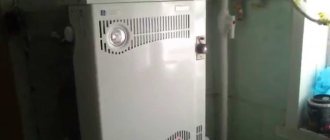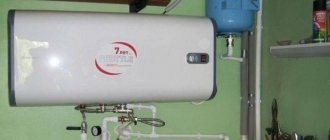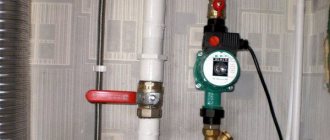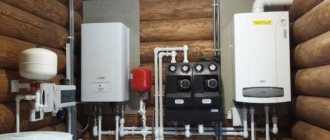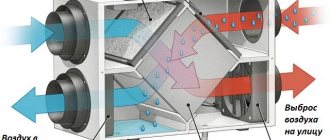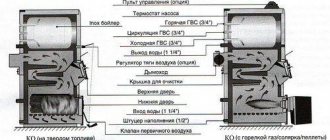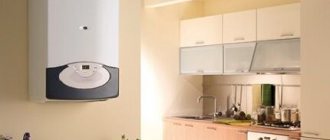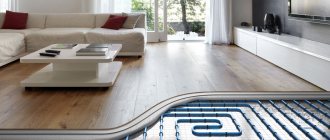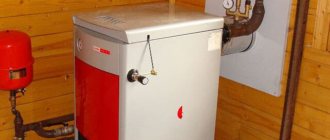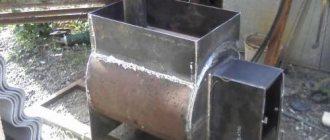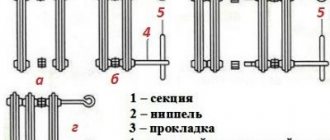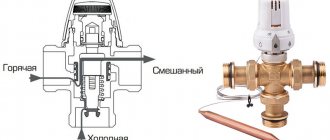The installation of plastic windows and sealed entrance doors has led to a change, or rather a deterioration, of the microclimate inside houses. There are two ways to solve the problem: organize efficient ventilation, which is not so cheap, or install a special device, the name of which is a supply valve to the wall. Let's look at this device specifically to understand how it works.
Supply valve in the wall above the battery Source cvc-market.ru
Need for installation
The main purpose of the supply valve is to ensure the flow of air from the street into the interior of the house. Why is this so important:
- If fresh air does not come from the street, the concentration of carbon dioxide in the house will begin to increase. And this will lead to a deterioration in the well-being of the people living in this house.
- Reduced air intake from outside creates conditions for increased humidity. And this is the reason for the appearance of colonies of harmful microorganisms in the form of mold and fungi. Accordingly, there is a high probability of developing asthma or allergies. Children, elderly people and family members with low immunity are at increased risk.
- High humidity also negatively affects building structures.
- If the house already has exhaust ventilation and the air flow is limited, then unpleasant odors and harmful substances in the air are poorly removed.
Of course, you can simply occasionally ventilate through the windows, but this is a temporary function that does not provide the proper concentration of fresh supply air.
Today, a window valve is increasingly being used as a means of bringing air in from outside. This is a good alternative. And we’ll also talk about it a little lower.
Supply window valve Source standart40.ru
Purpose of the device
The need for installation is explained by the fact that a modern apartment is a completely sealed room due to the fact that PVC windows do not allow air flow when closed. Opening them for ventilation is not always convenient, since in winter too much cold air enters.
In this regard, several difficulties arise at once:
- excess exhaled carbon dioxide accumulates in the room;
- chronic lack of oxygen leads to stuffiness, stuffy air and often heaviness in the head;
- moisture quickly accumulates in a confined space; systematic over-humidification of the air leads to the formation of mold on walls and products.
A supply valve mounted into the wall is convenient in that it creates a uniform and constant weak inflow, which essentially replaces the need to use a window during the cold period.
The valve is designed for use in any residential or commercial premises. Its use is especially relevant:
- if there are many people living in the apartment, especially small children;
- if there are often a lot of people in the room;
- if the apartment has pets and/or plants that constantly need fresh air.
The need for additional ventilation increases if the house is old, since in this case the natural ventilation system, which was installed during construction, most likely does not function or does not work effectively enough.
Design features and how the supply valve works
Purely structurally, the supply valve is a cylinder in which the filter material is placed. It is covered with decorative grilles on both sides. The cylinder diameter is from 6 to 14 cm. This parameter affects the performance of the device. That is, the more, the more air it passes through itself.
The cylinder itself is made of plastic. The external decorative grille protects the device from the penetration of small animals and birds, as well as from debris. Budget options are plastic, expensive ones are aluminum. Some manufacturers complete the grilles with mosquito nets.
The valve is closed from the inside with a cap. This is a box in which the filter material is installed. The head is closed with a lid. There is a wide variety of heads. With the help of some, you can reduce or increase the supply of incoming air. They can have different shapes, sizes, and locations of holes for air passage.
Design features of the supply valve Source veles24.ru
The cylinder is inserted into a drilled hole in the wall. To prevent noise from the street from penetrating into the house and to prevent the walls from freezing in winter, heat and sound insulation material is placed between the wall and the plastic cylinder. This is usually a cylindrical product.
As you can see, the design is very simple, but very effective. However, it should also be noted that the ventilation valve will be useless if the hood does not work well in the house. After all, the essence of ventilation is both the flow of air and its removal from the premises. Therefore, some tips:
- the hood must be in good condition at all times, even if it is a hole under the ceiling in the bathroom and kitchen;
- Interior doors should have bars or the height of the door leaf should be selected so that there is a gap of 15 mm between its lower edges and the floor.
The hood in the kitchen should work efficiently Source victorborisov.ru
Brief overview of the best manufacturers
When choosing a ventilator, users rely on different criteria. One of the important indicators of the duration and quality of operation of a supply valve is its manufacturer.
But sometimes the characteristics indicated in the product passport do not correspond to reality. To avoid such a situation, you should choose valves from well-known brands with a good reputation.
By choosing a supply valve from a well-known world brand that produces a wide range of ventilation equipment that has received recognition from millions of users, you can be confident in the reliability and practicality of the product
Next, we will briefly consider the best brands whose products are represented on the domestic market.
Vents automatic supply valves are considered the most popular solutions. Vents is a Ukrainian company that has won recognition from European users. Today, the manufacturer’s assortment includes more than 10,000 items.
Ventec is a Russian enterprise that produces aspiration and ventilation systems, specializing in the production of metal frame and cabinet products. The company has an excellent level of service.
Ballu brand supply valves are supplied to 30 countries. Ballu is a manufacturer specializing in engineering systems and climate control equipment. Having its own laboratories allows the company to use innovative solutions in production.
Tion is a Russian brand that is rapidly gaining popularity. ventilation, develops devices for highly efficient filtration and disinfection.
Advantages and disadvantages
The main advantage of the valve is that it can be used to easily increase the efficiency of the ventilation system. In this case, minimal funds are invested. The device itself is inexpensive, and its installation is just a matter of drilling a hole in the wall where the device is installed.
And other benefits:
- If we compare a wall-mounted supply ventilation valve with a window valve, it is many times more efficient and powerful. Its productivity varies between 60-70 m³/h. This is a serious indicator.
- There is no need to open windows. That is, the service life of the latter’s fittings, and therefore the window structures themselves, increases.
- Air from the street, passing through the filter, becomes cleaner. Dust will not pass through the valve, which means that the rooms will be much cleaner than if the rooms were ventilated through the windows.
- There is always the ability to regulate the incoming air flow. That is, you can adjust it taking into account the size of the room and the entire house, as well as taking into account the season.
- Air exchange through the valve is not accompanied by heat losses compared to window ventilation.
- The device operates offline. It doesn't require any energy.
The air flow is regulated by a damper Source pbs.twimg.com
See also: Catalog of companies that specialize in the installation of ventilation and air conditioning systems.
As for the shortcomings, they primarily relate to incorrect installation. And although manufacturers describe this process in detail in their instructions, home craftsmen manage to do something wrong. That's why:
- A hole in the wall reduces the strength of the supporting structure. The risk of loss of integrity is negligible.
- If the installation is carried out incorrectly, there is a high probability that the wall where the valve is installed will freeze.
- In severe frosts, cold air may leak through the device.
- The cylinder installed inside the wall becomes clogged with dust over time. It will have to be removed periodically.
It is believed that the supply valve is a source of penetration of cold air into the rooms from the outside, which reduces the temperature inside the house. If you install it in the wrong place, this can happen. Therefore, most often the device is mounted in the wall between the window sill and the heating radiator. That is, cold air entering the house is immediately heated by the heat of the heating system radiator. Of course, no one forbids installing the valve in some other place, but under the window is an ideal area.
It is better to carry out installation above the heating radiator Source strojdvor.ru
Adjustment
Adjusting the supply valve after its installation, or when changing seasons, is necessary to adjust the thermal characteristics of the enclosing structure, as well as to change the intensity of the air flow entering the room.
Automatic
The design of such a valve is based on a flexible petal , which automatically bends or closes when the humidity level in the room changes. Manual adjustment of such a product is possible, and is performed in cases where the technical characteristics of the product do not meet the requirements for the room or the wishes of the user.
To calibrate the automatic valve, you will need to dismantle the protective casing and then bend the movable flap of the equipment.
Manual
It is considered the most reliable way to change the intensity of air flow. To perform the procedure, you need to follow the technological map :
- Adjusting the position of the louvre grille.
- Setting the locking valve to the most comfortable position.
- Changing the position of the internal blocking flap, which is responsible for the internal cross-sectional area of the product.
When manually adjusting, it is important to constantly monitor the air temperature outside, since the consumer may accidentally allow the room to become overcooled, which will affect the microclimate and heating costs.
Selection rules
Before purchasing an exhaust ventilation valve for the wall, you need to determine the cubic capacity of the house in which natural ventilation is organized. Based on this, the diameter of the valve is selected, and accordingly its performance, as well as the number of installed devices.
In addition to performance, it is necessary to take into account the permissible operating temperature, cylinder length, and control method. All these parameters may be different for different manufacturers. And this will need to be taken into account.
For example, the average productivity is 40 m³/h. Taking into account the volume of the house and the number of people living in it, the brand of the device is selected. Some manufacturers are required to indicate the operating temperature range in the product data sheet. And if such a parameter is specified, then you should not violate it.
The length of the cylinder is determined by the thickness of the wall into which it is installed. As for the control method, supply units are presented on the market in the form of devices with manual or automatic control. The latter are the same valves, inside of which a hygrostat is installed - a device that monitors the humidity of the air inside the house. You only need to set the required humidity on the panel, the hygrostat itself will not only monitor it, but also issue commands to open or close the damper.
The performance of the inlet depends on its diameter Source 4shop.ru
Some tips
- The installed device must be cleaned periodically. It is especially important to do this for owners of city apartments, where soot and dirt from the street will inevitably settle on the filter of the device.
- Ventilation operation must be checked regularly. For this purpose, you can use a candle flame or paper cut into thin strips.
Example of a supply circulation device
If there is no ventilation system in the house
What is ventilation - it is a system consisting of two holes. Air from outside enters one, polluted and humid air exits into the other. Air exchange occurs, which is the key to the health of people living in the house. If exhaust ventilation in the house was installed during construction, then installing a supply valve solves all problems.
What if there is no such ventilation? Then you will have to create it. To do this, a supply and exhaust ventilation valve is installed in the wall, the latter is mounted under the ceiling. In this case, both devices are installed on opposite walls to create an air flow from bottom to top and diagonally across the room. That is, the process of natural ventilation follows the laws of physics, where warm air rises to the ceiling and creates pressure there. And cold air from the street comes in from below. It turns out to be a kind of draft that is not felt.
Today, manufacturers offer exhaust valves with a forced air exhaust system. Simply install a small fan in the cylinder, which turns on when necessary to quickly ventilate the room. Some models are equipped with a relay that can be used to regulate the speed of rotation of the fan blades. That is, air extraction can be organized in intensive mode or in weak mode.
Exhaust valve in the wall Source yandex.net
Types of ventilators
Supply devices differ in the following parameters:
- presence of air flow adjustment (mechanical or automatic);
- the presence of sound insulation and insulation;
- the presence of additional elements;
- the possibility of complete insulation of the air duct;
- in size and appearance.
Some devices may differ in the material of manufacture. There are plastic, metal or polystyrene foam models
Installation of the supply valve
Installing the device is a dusty and noisy process, because you have to check the wall. To do this you will need a diamond bit and a hammer drill. The craftsmen use a special tool – a diamond drilling rig.
The hole drilled in the wall must be cleaned of dust, for which a vacuum cleaner is used. Then the insulating material is inserted into the hole. Usually, today they use shells made of mineral wool or polyurethane, which are sold in 1 m lengths. They are simply cut to fit the width of the wall.
Note! The diameter of the diamond crown is selected to match the diameter of the insulation.
Next, the valve cylinder is inserted into the shell. From the outside, a decorative grille is attached to the wall with self-tapping screws and plastic dowels. With an internal head with filter material.
Making a valve for air flow with your own hands: step-by-step instructions
Along with purchased options, it is quite possible to make the device yourself. The design is very simple and consists of 4 elements:
- pipe;
- lattice;
- head;
- heat insulating layer.
Accordingly, you will need a plastic pipe with a grill, insulation and the housing itself with a valve. You should focus on the standard diameter of the finished product in the range of 120-130 mm. Moreover, for cold climate conditions it is better to choose an even smaller diameter (no more than 100 mm).
The entire sequence of actions is shown schematically in the figure.
- Insulation is inserted into the pipe. It should be at least a third of the entire length - it should be laid on the side of the room.
- The grille is placed on it from the outside - the main requirement is that it completely covers the pipe.
- A head is placed on the indoor part, installation is carried out using the same technology.
Window supply valve
As promised above, we will give a little information about the ventilation valve for plastic windows. Let's start with the fact that the tightness of plastic windows has led to big problems. Many manufacturers immediately responded to consumer demands. So, various devices began to be inserted into window frames, through which air began to flow into the rooms. Eg:
- ventilated profiles began to be used;
- limiters for opening frames and transoms were installed;
- seals with partial air permeability through them were used;
- glazing beads were installed, the design of which included an opening valve.
Opening limiter for plastic window frames Source www.ufa-okoshko.ru
Window supply valves have gained great popularity among consumers due to their high air exchange efficiency. They are presented in three types on the market:
- Folded. This device cuts into the window frame. That is, the installation can be carried out on the existing window structure without changing other parts or elements. This variety has one drawback - low productivity up to 5 m³/hour. But these are the cheapest valves.
- Slotted. These models are installed in the gap between the frame and the sash. This is what complicates the installation process. Otherwise, the devices are better than folded ones due to more efficient air exchange - up to 20 m³/h. The size of the inlets is limited only by the length of the gap.
- Invoices. These supply valves are installed on plastic windows during the installation of double-glazed windows. And on the one hand this is a minus. Another negative side is that the devices transmit a lot of noise, so they are not recommended for installation in homes. But the devices have high productivity - up to 100 m³/h. They can be installed in both fixed and opening windows.
Design
All supply valves have the same key design components:
- air duct A channel through which air passes from outside into a room. Usually made of plastic;
- external ventilation grille. Protects the air duct from atmospheric agents. Can be metal or plastic;
- inner part. It is presented with a plastic head and is usually sold disassembled. Includes a filter that purifies and directs air into the room.
In the photo of the supply valve to the wall you can clearly see the design of this product, its appearance, the variety of models and installation method.
The design contains special material to increase thermal insulation characteristics and sound insulation. There are valves that allow you to regulate the air flow.
In any stores where you can buy a fresh air ventilation valve, as a rule, there are also more complex models that can be equipped with additional devices:
- fan;
- recuperator (for heating air);
- temperature sensor;
- humidity sensor;
- remote control.
You can purchase a high-quality supply valve from Leroy Merlin. The hypermarket offers a huge selection of valve models, including those with additional functions.
If you don’t have this hypermarket in your city, you can find the valve in stores that sell equipment for ventilation systems.
Average prices in the Russian Federation
Currently, there are several large companies operating in the Russian Federation that produce and sell supply window systems. Average prices for products in the category under consideration :
- Aereco EMM 25 – 35 m3/h – from 3500 – 3700 rub.
- Air Box Eco with built-in filter – from 900 rub.
- Air Box Comfort, overhead design - from 450 - 500 rubles.
- Norvind Classic, with adjustable damper and deflector - from 1800 - 2000 rubles.
- Ventec VT 501, with automatic adjustment – from 800 – 850 rubles.
The prices listed above may vary slightly depending on the region of sale, the internal policy of the official dealer, the need for installation and seasonality.
Finally, about the importance of a full influx
In a “thermos” house with tightly sealed windows and entrance doors, the following happens:
- indoor air is humid and heavy;
- residents feel stuffy; windows are often opened for ventilation;
- unpleasant odors are slowly removed from the kitchen and bathroom;
- Gas-using equipment - household stoves, ovens, instantaneous water heaters - does not work well due to lack of oxygen.
Note. An insufficient amount of inflow provokes automatic shutdown of gas boilers - the draft or flame ionization sensor is triggered. Difficulty ignition is also observed - the electrodes “spark” for a long time, and when ignited, a strong bang is heard in the chamber.
A supply valve in the outer wall solves all of the above problems. When fresh air enters the house, the hood functions properly. The ventilation elements are distributed as follows: exhaust ducts are located in more contaminated rooms (kitchen, toilet), and inflow valves are located in living rooms.
